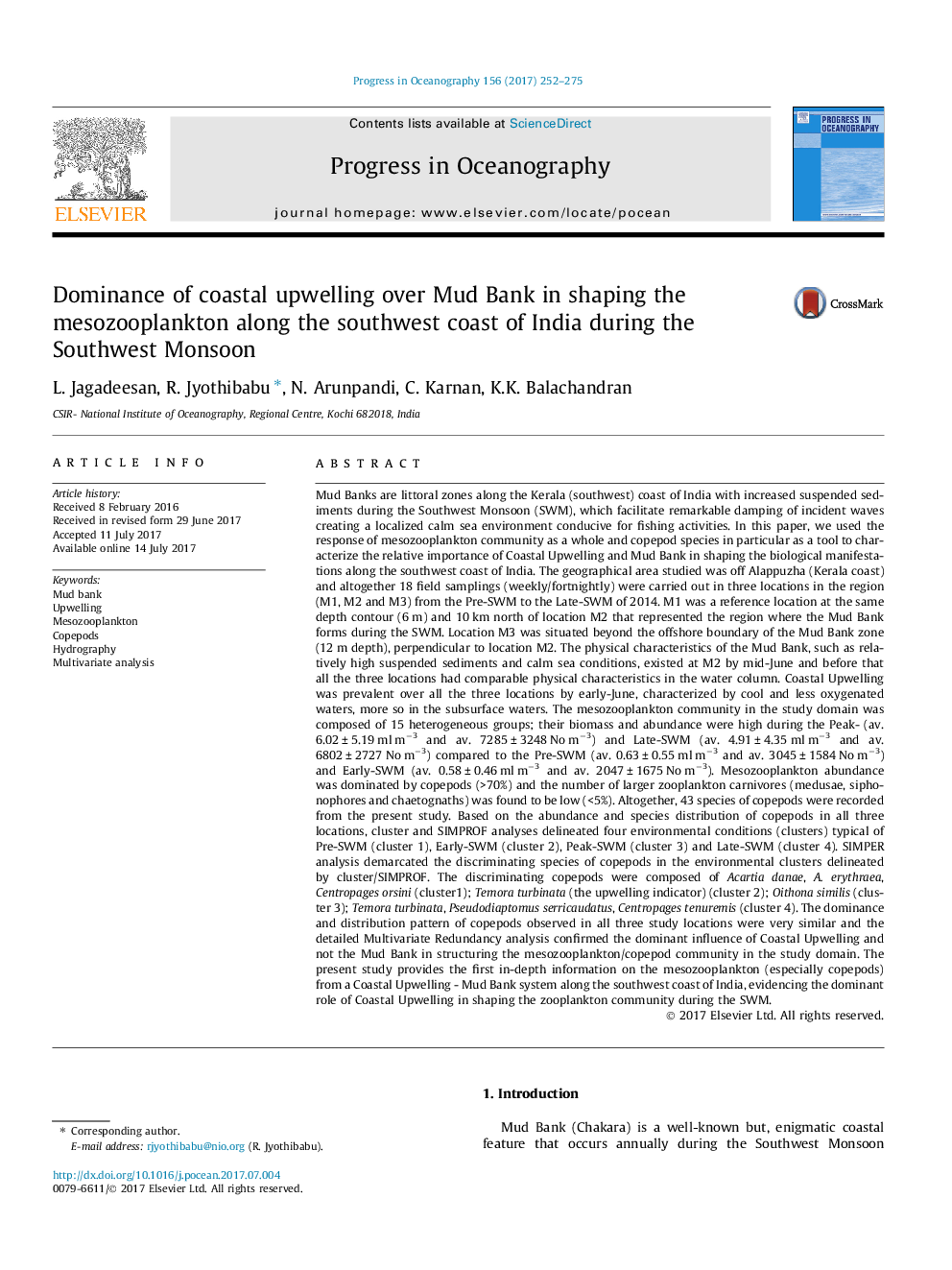| کد مقاله | کد نشریه | سال انتشار | مقاله انگلیسی | نسخه تمام متن |
|---|---|---|---|---|
| 5766487 | 1627902 | 2017 | 24 صفحه PDF | دانلود رایگان |

- Coastal Upwelling and Mud Bank co-occur along the southwest coast of India during the Southwest Monsoon period.
- Provided the first in-depth information on the zooplankton especially copepods from a coastal environment infested by both mud bank and upwelling.
- Hydrographical transformations during the Mud Bank-Upwelling events caused noticeable changes in the dominant copepods in the environment.
- Evidenced the dominant role of Coastal Upwelling in shaping the zooplankton community along the southwest coast of India.
Mud Banks are littoral zones along the Kerala (southwest) coast of India with increased suspended sediments during the Southwest Monsoon (SWM), which facilitate remarkable damping of incident waves creating a localized calm sea environment conducive for fishing activities. In this paper, we used the response of mesozooplankton community as a whole and copepod species in particular as a tool to characterize the relative importance of Coastal Upwelling and Mud Bank in shaping the biological manifestations along the southwest coast of India. The geographical area studied was off Alappuzha (Kerala coast) and altogether 18 field samplings (weekly/fortnightly) were carried out in three locations in the region (M1, M2 and M3) from the Pre-SWM to the Late-SWM of 2014. M1 was a reference location at the same depth contour (6 m) and 10 km north of location M2 that represented the region where the Mud Bank forms during the SWM. Location M3 was situated beyond the offshore boundary of the Mud Bank zone (12 m depth), perpendicular to location M2. The physical characteristics of the Mud Bank, such as relatively high suspended sediments and calm sea conditions, existed at M2 by mid-June and before that all the three locations had comparable physical characteristics in the water column. Coastal Upwelling was prevalent over all the three locations by early-June, characterized by cool and less oxygenated waters, more so in the subsurface waters. The mesozooplankton community in the study domain was composed of 15 heterogeneous groups; their biomass and abundance were high during the Peak- (av. 6.02 ± 5.19 ml mâ3 and av. 7285 ± 3248 No mâ3) and Late-SWM (av. 4.91 ± 4.35 ml mâ3 and av. 6802 ± 2727 No mâ3) compared to the Pre-SWM (av. 0.63 ± 0.55 ml mâ3 and av. 3045 ± 1584 No mâ3) and Early-SWM (av. 0.58 ± 0.46 ml mâ3 and av. 2047 ± 1675 No mâ3). Mesozooplankton abundance was dominated by copepods (>70%) and the number of larger zooplankton carnivores (medusae, siphonophores and chaetognaths) was found to be low (<5%). Altogether, 43 species of copepods were recorded from the present study. Based on the abundance and species distribution of copepods in all three locations, cluster and SIMPROF analyses delineated four environmental conditions (clusters) typical of Pre-SWM (cluster 1), Early-SWM (cluster 2), Peak-SWM (cluster 3) and Late-SWM (cluster 4). SIMPER analysis demarcated the discriminating species of copepods in the environmental clusters delineated by cluster/SIMPROF. The discriminating copepods were composed of Acartia danae, A. erythraea, Centropages orsini (cluster1); Temora turbinata (the upwelling indicator) (cluster 2); Oithona similis (cluster 3); Temora turbinata, Pseudodiaptomus serricaudatus, Centropages tenuremis (cluster 4). The dominance and distribution pattern of copepods observed in all three study locations were very similar and the detailed Multivariate Redundancy analysis confirmed the dominant influence of Coastal Upwelling and not the Mud Bank in structuring the mesozooplankton/copepod community in the study domain. The present study provides the first in-depth information on the mesozooplankton (especially copepods) from a Coastal Upwelling - Mud Bank system along the southwest coast of India, evidencing the dominant role of Coastal Upwelling in shaping the zooplankton community during the SWM.
Journal: Progress in Oceanography - Volume 156, August 2017, Pages 252-275